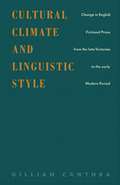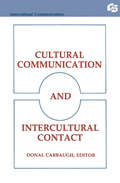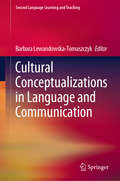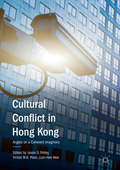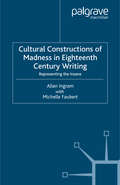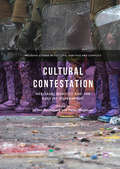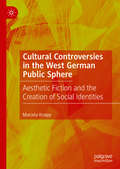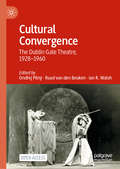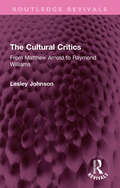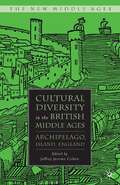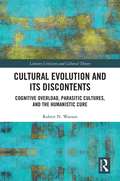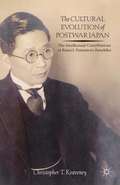- Table View
- List View
Cultural Capital: The Problem of Literary Canon Formation
by John GuilloryAn enlarged edition to celebrate the thirtieth anniversary of John Guillory’s formative text on the literary canon. Since its publication in 1993, John Guillory’s Cultural Capital has been a signal text for understanding the codification and uses of the literary canon. Cultural Capital reconsiders the social basis for aesthetic judgment and exposes the unequal distribution of symbolic and linguistic knowledge on which culture has long been based. Drawing from Pierre Bourdieu’s sociology, Guillory argues that canon formation must be understood less as a question of the representation of social groups and more as a question of the distribution of cultural capital in schools, which regulate access to literacy, to the practices of reading and writing. Now, as the crisis of the canon has evolved into the so-called crisis of the humanities, Guillory’s groundbreaking, incisive work has never been more urgent. As scholar and critic Merve Emre writes in her introduction to this enlarged edition: “Exclusion, selection, reflection, representation—these are the terms on which the canon wars of the last century were fought, and the terms that continue to inform debates about, for instance, decolonizing the curriculum and the rhetoric of antiracist pedagogy.”
Cultural Capitals: Early Modern London and Paris
by Karen NewmanSocial theories of modernity focus on the nineteenth century as the period when Western Europe was transformed by urbanization. Cities became thriving metropolitan centers as a result of economic, political, and social changes wrought by the industrial revolution. In Cultural Capitals, Karen Newman demonstrates that speculation and capital, the commodity, the crowd, traffic, and the street, often thought to be historically specific to nineteenth-century urban culture, were in fact already at work in early modern London and Paris. Newman challenges the notion of a rupture between premodern and modern societies and shows how London and Paris became cultural capitals. Drawing upon poetry, plays, and prose by writers such as Shakespeare, Scudéry, Boileau, and Donne, as well as popular materials including pamphlets, ballads, and broadsides, she examines the impact of rapid urbanization on cultural production. Newman shows how changing demographics and technological development altered these two emerging urban centers in which new forms of cultural capital were produced and new modes of sociability and representation were articulated.Cultural Capitals is a fascinating work of literary and cultural history that redefines our conception of when the modern city came to be and brings early modern London and Paris alive in all their splendor, squalor, and richness.
A Cultural Citizen of the World: Sigmund Freud's Knowledge and Use of British and American Writings
by S. S. PrawerThis book is based on the German editions of Sigmund Freud's works and letters. It presents various examples from English and American literatures that suggest several questions Freud asked of literary works in general.
A Cultural Citizen of the World: Sigmund Freud's Knowledge and Use of British and American Writings
by S. S. PrawerThis book is based on the German editions of Sigmund Freud's works and letters. It presents various examples from English and American literatures that suggest several questions Freud asked of literary works in general.
Cultural Climate and Linguistic Style: Change in English Fictional Prose from the Late Victorian to the Early Modern Period
by Gillian CawthraA book exploring the relation between culture and syntax at the end of the 19th and the beginning of the 20th centuries. The analysis of particular syntactic features in novels of the time shows clear differences of usage which may be seen to reflect current social upheaval.
Cultural Communication and Intercultural Contact (Routledge Communication Series)
by Donal CarbaughHow is cultural identity accomplished interactively? What happens when different cultural identities contact one another? This book presents a series of papers, from classic essays to original expositions, which respond to these questions. The view of communication offered here -- rather than ignoring culture, or making it a variable in an equation -- is based on cultural patterns and situated communication practices, unveiling the multiplicity of factors involved in particular times and places. The contributors to this unusual volume represent a wide range of fields. Their equally diverse offerings will serve to clarify cultural distinctiveness in some communication phenomena, and lay groundwork for the identification of cross-cultural generalities in others.
Cultural Communication and Intercultural Contact (Routledge Communication Series)
by Donal CarbaughHow is cultural identity accomplished interactively? What happens when different cultural identities contact one another? This book presents a series of papers, from classic essays to original expositions, which respond to these questions. The view of communication offered here -- rather than ignoring culture, or making it a variable in an equation -- is based on cultural patterns and situated communication practices, unveiling the multiplicity of factors involved in particular times and places. The contributors to this unusual volume represent a wide range of fields. Their equally diverse offerings will serve to clarify cultural distinctiveness in some communication phenomena, and lay groundwork for the identification of cross-cultural generalities in others.
Cultural Conceptualizations in Language and Communication (Second Language Learning and Teaching)
by Barbara Lewandowska-TomaszczykThe book comprises a selection of papers concerning the general theme of cultural conceptualizations in language. The focus of Part 1, which includes four papers, is on Metaphor and Culture, discussing general as well as language-specific metaphoricity.Part 2, which also includes three papers, is on Cultural Models, dealing with phenomena relating to family and home, nation and kinship, blood, and death in different cultures. Six papers in Part 3, which refers to questions of Identity and Cultural Stereotypes, both in general language and in literature, discuss identity in native and migration contexts and take up motifs of journey and migration, as well as social and cultural stereotypes and prejudice in transforming contexts. Three papers in the last Part 4 of the book, Linguistic Concepts, Meanings, and Interaction, focus on the semantic interpretation of the changes and differences which occur in their intra- as well as inter-linguistic contexts.
Cultural Conceptualizations in Translation and Language Applications (Second Language Learning and Teaching)
by Barbara Lewandowska-TomaszczykThe book comprises a selection of 14 papers concerning the general theme of cultural conceptualizations in communication and translation, as well as in various applications of language.Ten papers in first part Translation and Culture cover the topics of a cognitive approach to conceptualizations of Source Language – versus Target Language – texts in translation, derived from general language, media texts, and literature.The second part Applied Cultural Models comprises four papers discussing cultural conceptualizations of language in the educational context, particularly of Foreign Language Teaching, in online communication and communication in deaf communities.
Cultural Conflict in Hong Kong: Angles on a Coherent Imaginary
by Jason S. Polley Lian-Hee Wee Vinton W.K. PoonThis book examines how in navigating Hong Kong’s colonial history alongside its ever-present Chinese identity, the city has come to manifest a conflicting socio-cultural plurality. Drawing together scholars, critics, commentators, and creators on the vanguard of the emerging field of Hong Kong Studies, the essay volume presents a gyroscopic perspective that discerns what is made in from what is made into Hong Kong while weaving a patchwork of the territory’s contested local imaginary. This collection celebrates as it critiques the current state of Hong Kong society on the 20th anniversary of its handover to China. The gyroscopic outlook of the volume makes it a true area studies book-length treatment of Hong Kong, and a key and interdisciplinary read for students and scholars wishing to explore the territory’s complexities.
Cultural Conflict in Hong Kong: Angles on a Coherent Imaginary
by Jason S. Polley Lian-Hee Wee Vinton W.K. PoonThis book examines how in navigating Hong Kong’s colonial history alongside its ever-present Chinese identity, the city has come to manifest a conflicting socio-cultural plurality. Drawing together scholars, critics, commentators, and creators on the vanguard of the emerging field of Hong Kong Studies, the essay volume presents a gyroscopic perspective that discerns what is made in from what is made into Hong Kong while weaving a patchwork of the territory’s contested local imaginary. This collection celebrates as it critiques the current state of Hong Kong society on the 20th anniversary of its handover to China. The gyroscopic outlook of the volume makes it a true area studies book-length treatment of Hong Kong, and a key and interdisciplinary read for students and scholars wishing to explore the territory’s complexities.
Cultural Constructions of Madness in Eighteenth-Century Writing: Representing the Insane
by A. Ingram M. FaubertCultural Constructions of Madness in the Eighteenth Century deals with the (mis)representation of insanity through a substantial range of literary forms and figures from across the eighteenth century and beyond. Chapters cover the representation, distortion, sentimentalization and elevation of insanity, and such associated issues as gender, personal identity, and performance, in some of the best, as well as some of the least, known writers of the period. A selection of visual material, including works by Hogarth, Rowlandson, and Gillray, is also discussed. While primarily adopting a literary focus, the work is informed throughout by an alertness to significant issues of medical and psychiatric history.
Cultural Contestation: Heritage, Identity and the Role of Government (Palgrave Studies in Cultural Heritage and Conflict)
by Jeroen Rodenberg Pieter WagenaarHeritage practices often lead to social exclusion, as such practices can favor certain values over others. In some cases, exclusion from a society’s symbolic landscape can spark controversy, or rouse emotion so much so that they result in cultural contestation. Examples of this abound, but few studies explicitly analyze the role of government in these instances. In this volume, scholars from a variety of academic backgrounds examine the various and often conflicting roles governments play in these processes—and governments do play a role. They act as authors and authorizers of the symbolic landscape, from which societal groups may feel excluded. Yet, they also often attempt to bring parties together and play a mitigating role.
Cultural Contestation: Heritage, Identity and the Role of Government (Palgrave Studies in Cultural Heritage and Conflict)
by Jeroen Rodenberg Pieter WagenaarHeritage practices often lead to social exclusion, as such practices can favor certain values over others. In some cases, exclusion from a society’s symbolic landscape can spark controversy, or rouse emotion so much so that they result in cultural contestation. Examples of this abound, but few studies explicitly analyze the role of government in these instances. In this volume, scholars from a variety of academic backgrounds examine the various and often conflicting roles governments play in these processes—and governments do play a role. They act as authors and authorizers of the symbolic landscape, from which societal groups may feel excluded. Yet, they also often attempt to bring parties together and play a mitigating role.
Cultural Controversies in the West German Public Sphere: Aesthetic Fiction and the Creation of Social Identities
by Marcela KnappThis book develops a theory of aesthetic fiction’s impact on social identities. Throughout five case studies, the author develops the argument that social identities are nurtured by and may even emerge through the conflict between different aesthetic expressions. As it creates affective structures, narrative fiction enables the development and formation of political and cultural identities. This work is part of a field of research that deals with the aesthetics of the everyday and the idea of social aesthetics. It argues for a central role for the arts in the creation and formation of modern society. Social identities emerge in response to aesthetic-sensual patterns of perception.Focusing on five West German public debates in the years 1950 to 1990, this work sheds light upon the transformation of social reality through the discursive adaption of art.
Cultural Convergence: The Dublin Gate Theatre, 1928–1960
by Ondřej Pilný Ian R. Walsh Ruud van den BeukenBased on extensive archival research, this open access book examines the poetics and politics of the Dublin Gate Theatre (est. 1928) over the first three decades of its existence, discussing some of its remarkable productions in the comparative contexts of avant-garde theatre, Hollywood cinema, popular culture, and the development of Irish-language theatre, respectively. The overarching objective is to consider the output of the Gate in terms of cultural convergence – the dynamics of exchange, interaction, and acculturation that reveal the workings of transnational infrastructures.
The Cultural Critics: From Matthew Arnold to Raymond Williams (Routledge Revivals)
by Lesley JohnsonOriginally published in 1979, the central focus of this study is the concept of culture as employed by English literary intellectuals over the preceding 100 years, a period characterized by a constant process of re-definition and change. The tradition of criticism in which these intellectuals wrote represented the artistic imagination as a moral force in society and a fundamental mechanism for social change. The author traces this tradition through the writings of various English intellectuals, using the three main figures of Matthew Arnold, F. R. Leavis and Raymond Williams to elucidate the concept. She shows, through the writings of their contemporaries, how the concept was employed and modified, and her analysis ranges from J. S. Mill, John Ruskin and William Morris, through George Bernard Shaw, D. H. Lawrence, T. S. Eliot and R. H. Tawney to Richard Hoggard, Richard Wollheim and R. S. Peters. By discussing the questions of the role of art in society and examining their treatment by different groups of intellectuals, the author has supplied a basis for a forceful critique of the quality of life in modern industrial society. This book will be of interest to students of literature, cultural history and the sociology of culture.
The Cultural Critics: From Matthew Arnold to Raymond Williams (Routledge Revivals)
by Lesley JohnsonOriginally published in 1979, the central focus of this study is the concept of culture as employed by English literary intellectuals over the preceding 100 years, a period characterized by a constant process of re-definition and change. The tradition of criticism in which these intellectuals wrote represented the artistic imagination as a moral force in society and a fundamental mechanism for social change. The author traces this tradition through the writings of various English intellectuals, using the three main figures of Matthew Arnold, F. R. Leavis and Raymond Williams to elucidate the concept. She shows, through the writings of their contemporaries, how the concept was employed and modified, and her analysis ranges from J. S. Mill, John Ruskin and William Morris, through George Bernard Shaw, D. H. Lawrence, T. S. Eliot and R. H. Tawney to Richard Hoggard, Richard Wollheim and R. S. Peters. By discussing the questions of the role of art in society and examining their treatment by different groups of intellectuals, the author has supplied a basis for a forceful critique of the quality of life in modern industrial society. This book will be of interest to students of literature, cultural history and the sociology of culture.
Cultural Diversity in the British Middle Ages: Archipelago, Island, England (The New Middle Ages)
by J. CohenThrough close readings of both familiar and obscure medieval texts, the contributors to this volume attempt to read England as a singularly powerful entity within a vast geopolitical network. This capacious world can be glimpsed in the cultural flows connecting the Normans of Sicily with the rulers of England, or Chaucer with legends arriving from Bohemia. It can also be seen in surprising places in literature, as when green children are discovered in twelfth-century Yorkshire or when Welsh animals begin to speak of the long history of their land s colonization. The contributors to this volume seek moments of cultural admixture and heterogeneity within texts that have often been assumed to belong to a single, national canon, discovering moments when familiar and bounded space erupt into unexpected diversity and infinite realms.
Cultural Encounters in Translated Children's Literature
by Helen FrankCultural Encounters in Translated Children's Literature offers a detailed and innovative model of analysis for examining the complexities of translating children's literature and sheds light on the interpretive choices at work in moving texts from one culture to another. The core of the study addresses the issue of how images of a nation, locale or country are constructed in translated children's literature, with the translation of Australian children's fiction into French serving as a case study. Issues examined include the selection of books for translation, the relationship between children's books and the national and international publishing industry, the packaging of translations and the importance of titles, blurbs and covers, the linguistic and stylistic features specific to translating for children, intertextual references, the function of the translation in the target culture, didactic and pedagogical aims, euphemistic language and explicitation, and literariness in translated texts. The findings of the case study suggest that the most common constructs of Australia in French translations reveal a preponderance of traditional Eurocentric signifiers that identify Australia with the outback, the antipodes, the exotic, the wild, the unknown, the void, the end of the world, the young and innocent nation, and the Far West. Contemporary signifiers that construct Australia as urban, multicultural, Aboriginal, worldly and inharmonious are seriously under-represented. The study also shows that French translations are conventional, conservative and didactic, showing preference for an exotic rather than local specificity, with systematic manipulation of Australian referents betraying a perception of Australia as antipodean rural exoticism. The significance of the study lies in underscoring the manner in which a given culture is constructed in another cultural milieu, especially through translated children's literature.
Cultural Encounters in Translated Children's Literature
by Helen FrankCultural Encounters in Translated Children's Literature offers a detailed and innovative model of analysis for examining the complexities of translating children's literature and sheds light on the interpretive choices at work in moving texts from one culture to another. The core of the study addresses the issue of how images of a nation, locale or country are constructed in translated children's literature, with the translation of Australian children's fiction into French serving as a case study. Issues examined include the selection of books for translation, the relationship between children's books and the national and international publishing industry, the packaging of translations and the importance of titles, blurbs and covers, the linguistic and stylistic features specific to translating for children, intertextual references, the function of the translation in the target culture, didactic and pedagogical aims, euphemistic language and explicitation, and literariness in translated texts. The findings of the case study suggest that the most common constructs of Australia in French translations reveal a preponderance of traditional Eurocentric signifiers that identify Australia with the outback, the antipodes, the exotic, the wild, the unknown, the void, the end of the world, the young and innocent nation, and the Far West. Contemporary signifiers that construct Australia as urban, multicultural, Aboriginal, worldly and inharmonious are seriously under-represented. The study also shows that French translations are conventional, conservative and didactic, showing preference for an exotic rather than local specificity, with systematic manipulation of Australian referents betraying a perception of Australia as antipodean rural exoticism. The significance of the study lies in underscoring the manner in which a given culture is constructed in another cultural milieu, especially through translated children's literature.
Cultural Evolution and its Discontents: Cognitive Overload, Parasitic Cultures, and the Humanistic Cure (Literary Criticism and Cultural Theory)
by Robert N. WatsonPeople worry that computers, robots, interstellar aliens, or Satan himself – brilliant, stealthy, ruthless creatures – may seize control of our world and destroy what’s uniquely valuable about the human race. Cultural Evolution and its Discontents shows that our cultural systems – especially those whose last names are "ism" – are already doing that, and doing it so adeptly that we seldom even notice. Like other parasites, they’ve blindly evolved to exploit us for their own survival. Creative arts and humanistic scholarship are our best tools for diagnosis and cure. The assemblages of ideas that have survived, like the assemblages of biological cells that have survived, are the ones good at protecting and reproducing themselves. They aren’t necessarily the ones that guide us toward our most admirable selves or our healthiest future. Relying so heavily on culture to protect our uniquely open minds from cognitive overload makes us vulnerable to hijacking by the systems that co-evolve with us. Recognizing the selfish Darwinian functions of these systems makes sense of many aspects of history, politics, economics, and popular culture. What drove the Protestant Reformation? Why have the Beatles, The Hunger Games, and paranoid science-fiction thrived, and how was hip-hop co-opted? What alliances helped neoliberalism out-compete Communism, and what alliances might enable environmentalism to overcome consumerism? Why are multiculturalism and university-trained elites provoking working-class nationalist backlash? In a digital age, how can we use numbers without having them use us instead? Anyone who has wondered how our species can be so brilliant and so stupid at the same time may find an answer here: human mentalities are so complex that we crave the simplifications provided by our cultures, but the cultures that thrive are the ones that blind us to any interests that don’t correspond to their own.
Cultural Evolution and its Discontents: Cognitive Overload, Parasitic Cultures, and the Humanistic Cure (Literary Criticism and Cultural Theory)
by Robert N. WatsonPeople worry that computers, robots, interstellar aliens, or Satan himself – brilliant, stealthy, ruthless creatures – may seize control of our world and destroy what’s uniquely valuable about the human race. Cultural Evolution and its Discontents shows that our cultural systems – especially those whose last names are "ism" – are already doing that, and doing it so adeptly that we seldom even notice. Like other parasites, they’ve blindly evolved to exploit us for their own survival. Creative arts and humanistic scholarship are our best tools for diagnosis and cure. The assemblages of ideas that have survived, like the assemblages of biological cells that have survived, are the ones good at protecting and reproducing themselves. They aren’t necessarily the ones that guide us toward our most admirable selves or our healthiest future. Relying so heavily on culture to protect our uniquely open minds from cognitive overload makes us vulnerable to hijacking by the systems that co-evolve with us. Recognizing the selfish Darwinian functions of these systems makes sense of many aspects of history, politics, economics, and popular culture. What drove the Protestant Reformation? Why have the Beatles, The Hunger Games, and paranoid science-fiction thrived, and how was hip-hop co-opted? What alliances helped neoliberalism out-compete Communism, and what alliances might enable environmentalism to overcome consumerism? Why are multiculturalism and university-trained elites provoking working-class nationalist backlash? In a digital age, how can we use numbers without having them use us instead? Anyone who has wondered how our species can be so brilliant and so stupid at the same time may find an answer here: human mentalities are so complex that we crave the simplifications provided by our cultures, but the cultures that thrive are the ones that blind us to any interests that don’t correspond to their own.
The Cultural Evolution of Postwar Japan: The Intellectual Contributions of Kaiz?’s Yamamoto Sanehiko
by Christopher KeaveneyYamamoto Sanehiko's (1885-1952) achievements as a publisher, writer, and politician in the interwar period served as both a catalyst and a template for developments after the wars. While exploring the accomplishments the compelling figure, this study sheds new light on the social, cultural, and political changes that occurred in postwar Japan.
The Cultural Foundations of Nations: Hierarchy, Covenant, and Republic
by Anthony D. SmithThis major new work by Professor Anthony D. Smith challenges the notion of nationalism as a product of modernity. Major new work by a leading historical sociologist Challenges the prevailing idea of nationalism as a product of modernity Demonstrates that different political forms of community and collective identity from pre-modern times have contributed to the formation and character of nations Analyzes the chronology and nature of nations, from the ancient world, to the European Middle Ages, the early modern, and the modern eras Discusses alternative destinies facing modern nations today



